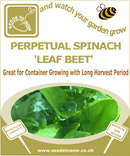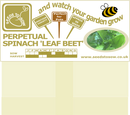Description
Perpetual Spinach 'Leaf Beet' is actually not a spinach at all but a kind of chard and a member of the beetroot family. It grows, looks and tastes very similar to Spinach. The one major advantage it has over spinach is that it does not run to seed in warm/dry conditions like spinach can and therefore it is an extremely useful and productive crop to have in any garden.
Spinach Perpetual continues to grow as a cut and come again crop and is very hardy (it will crop almost all year round which is why it is called perpetual). Perpetual Spinach is a great container vegetable and is perfect for pots in small spaces, patios and balconies.
| When to Sow | April to June for summer cropping, or in August/September to overwinter. |
| Where to Sow | Perpetual spinach will grow almost anywhere, but prefers fertile and well draining soil in a open sunny site. Preferred pH neutral to slightly acidic (6.5pH to 7.0pH) soil. |
| Early sowings can be made indoors, in modules or trays. Sow 1 seed cluster per module 1cm (1/2in) deep. | |
| Sow outdoors in final growing position, 1cm (1/2in) deep, 5cm (2in) apart with rows 30 cm (12in) apart. | |
| What to do Next | For indoor sowings, once the seedlings appear transplant to final growing position after hardening off for 7 days. Plant 15cm (6in) apart in rows 30cm (12in) apart. |
| For outdoor sowings, as seedlings appear thin out weakest seedlings gradually until plants are spaced 15cm (6in)apart. | |
| If growing in a pot or container aim to have about 5 plants growing to maturity once you have thinned out seedlings. | |
| Protect young seedlings from birds. | |
| Water well, especially during periods of dry weather, and keep weed free. | |
| Harvest | June to March. |
| Cut leaves as soon as they are large enough to harvest, this will usually be 35- 49 days (5-7 weeks) after sowing. | |
| Handy Tips | Regular cropping of leaves encourages new growth. Cut young leaves for salads, leaving the more mature leaves for cooking. |
| Spinach perpetual is naturally a perennial and will continue cropping in a second year, although it will not be as vigorous. If left to seed they will self-sow and seedlings can be transplanted to a new site. | |
| Companion Planting | Good companion: Brassicas and beans. |
| Bad companion: Cucumbers, potatoes, tomatoes. | |
| Nutritional Information | Rich in Beta carotene, calcium and iron. |
| Serving Suggestion | The young leaves can be used in salads or use the more mature leaves as you would spinach, either steamed and served as any other green vegetable or added to quiche, lasagne, pies, pasta, curries or as a pizza topping. |
Payment & Security
Your payment information is processed securely. We do not store credit card details nor have access to your credit card information.




